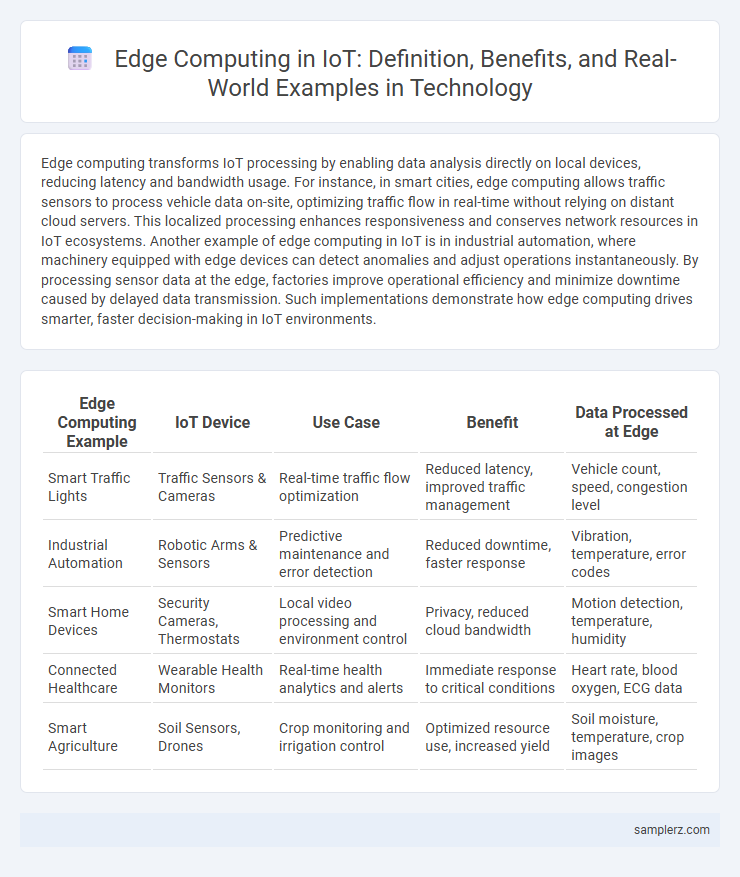Edge computing transforms IoT processing by enabling data analysis directly on local devices, reducing latency and bandwidth usage. For instance, in smart cities, edge computing allows traffic sensors to process vehicle data on-site, optimizing traffic flow in real-time without relying on distant cloud servers. This localized processing enhances responsiveness and conserves network resources in IoT ecosystems. Another example of edge computing in IoT is in industrial automation, where machinery equipped with edge devices can detect anomalies and adjust operations instantaneously. By processing sensor data at the edge, factories improve operational efficiency and minimize downtime caused by delayed data transmission. Such implementations demonstrate how edge computing drives smarter, faster decision-making in IoT environments.
Table of Comparison
| Edge Computing Example | IoT Device | Use Case | Benefit | Data Processed at Edge |
|---|---|---|---|---|
| Smart Traffic Lights | Traffic Sensors & Cameras | Real-time traffic flow optimization | Reduced latency, improved traffic management | Vehicle count, speed, congestion level |
| Industrial Automation | Robotic Arms & Sensors | Predictive maintenance and error detection | Reduced downtime, faster response | Vibration, temperature, error codes |
| Smart Home Devices | Security Cameras, Thermostats | Local video processing and environment control | Privacy, reduced cloud bandwidth | Motion detection, temperature, humidity |
| Connected Healthcare | Wearable Health Monitors | Real-time health analytics and alerts | Immediate response to critical conditions | Heart rate, blood oxygen, ECG data |
| Smart Agriculture | Soil Sensors, Drones | Crop monitoring and irrigation control | Optimized resource use, increased yield | Soil moisture, temperature, crop images |
Smart Home Automation with Edge Computing
Edge computing in smart home automation processes IoT data locally on devices like smart hubs and security cameras, reducing latency and enhancing real-time responsiveness. By analyzing data such as motion detection and temperature changes on-site, these systems optimize energy consumption and improve security without relying on cloud connectivity. This localized processing minimizes bandwidth use and ensures continuous operation during internet outages, increasing overall reliability in smart homes.
Real-Time Traffic Monitoring in Smart Cities
Real-time traffic monitoring in smart cities utilizes edge computing to process vast amounts of IoT sensor data directly at the network edge, reducing latency and enabling instant decision-making. By analyzing video feeds, vehicle counts, and environmental sensors onsite, edge devices optimize traffic signal timings and detect congestion or accidents immediately. This localized data processing enhances urban mobility, reduces emissions, and improves overall traffic management efficiency.
Industrial IoT for Predictive Maintenance
Edge computing in Industrial IoT enables real-time analysis of sensor data from machinery to detect anomalies and predict equipment failures before downtime occurs. By processing data locally on edge devices, latency is significantly reduced, allowing immediate corrective actions and minimizing operational disruptions. This approach enhances maintenance efficiency, lowers costs, and improves overall equipment effectiveness in smart factories.
Autonomous Vehicles and Edge Data Processing
Edge computing enhances IoT processing in autonomous vehicles by enabling real-time decision-making through on-device data analysis. This approach reduces latency by processing sensor data locally rather than relying on centralized cloud servers, improving vehicle safety and responsiveness. Edge data processing in autonomous systems supports rapid object detection, navigation, and communication with nearby infrastructure for optimized traffic flow and accident prevention.
Healthcare Wearables and Local Data Analytics
Healthcare wearables leverage edge computing to process data locally, enabling real-time health monitoring and immediate response to critical conditions. By utilizing on-device sensors and local data analytics, these devices reduce latency and dependency on cloud servers, enhancing patient privacy and operational efficiency. This approach supports continuous health data tracking, early disease detection, and personalized treatment through immediate analysis at the edge.
Smart Agriculture with Edge-Enabled Sensors
Edge computing in IoT processing significantly enhances smart agriculture through edge-enabled sensors that analyze soil moisture, temperature, and nutrient levels in real time. These sensors reduce latency by processing data locally on edge devices, enabling faster decision-making for irrigation and crop management. This decentralized approach optimizes resource usage and improves crop yield by minimizing reliance on cloud connectivity and bandwidth.
Retail IoT: Edge Processing for Customer Insights
Retail IoT leverages edge computing to process customer data locally at sensors and devices within stores, enabling real-time analytics and faster decision-making. Edge nodes analyze shopper behavior, inventory levels, and environmental conditions, reducing latency and bandwidth usage compared to cloud-only systems. This localized processing improves personalized promotions, inventory management, and enhances overall customer experience with immediate insights.
Remote Environmental Monitoring Using Edge Devices
Edge computing in IoT enables remote environmental monitoring by processing sensor data locally on edge devices, reducing latency and bandwidth use. These edge devices analyze real-time information such as temperature, humidity, and air quality, facilitating immediate response and decision-making in agricultural fields or wildlife reserves. By minimizing data transmission to centralized cloud servers, edge computing enhances the efficiency and reliability of environmental monitoring systems.
Energy Management in Smart Grids via Edge Computing
Edge computing in energy management for smart grids enables real-time processing of IoT sensor data at the network's edge, reducing latency and improving grid reliability. By analyzing consumption patterns locally, edge devices optimize energy distribution and minimize power losses, enhancing overall efficiency. This decentralized approach supports faster fault detection and load balancing, crucial for integrating renewable energy sources and maintaining grid stability.
Enhanced Security Systems with Edge-Based IoT
Edge computing in IoT processing enables enhanced security systems by analyzing data locally on edge devices, reducing latency and minimizing exposure to cyber threats. This decentralized approach allows for immediate threat detection and response, improving real-time surveillance and intrusion prevention. Edge-based IoT architectures optimize bandwidth usage and ensure critical security data remains within private networks, strengthening overall system resilience.

example of edge computing in IoT processing Infographic
 samplerz.com
samplerz.com